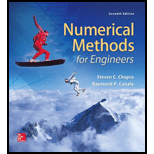
Use Newton's interpolating polynomial to determine y at
| x | 0 | 1 | 2 | 5.5 | 11 | 13 | 16 | 18 |
| y | 0.5 | 3.134 | 5.3 | 9.9 | 10.2 | 9.35 | 7.2 | 6.2 |
To calculate: The value of
| x | 0 | 1 | 2 | 5.5 | 11 | 13 | 16 | 18 |
| y | 0.5 | 3.134 | 5.3 | 9.9 | 10.2 | 9.35 | 7.2 | 6.2 |
Answer to Problem 10P
Solution:
Thevalue of
Explanation of Solution
Given Information:
The provided data are,
| x | 0 | 1 | 2 | 5.5 | 11 | 13 | 16 | 18 |
| y | 0.5 | 3.134 | 5.3 | 9.9 | 10.2 | 9.35 | 7.2 | 6.2 |
Formula used:
The zero-order Newton’s interpolation formula:
The first-order Newton’s interpolation formula:
The second- order Newton’s interpolating polynomial is given by,
The n th-order Newton’s interpolating polynomial is given by,
Where,
The first finite divided difference is,
And, the n th finite divided difference is,
Calculation:
First, order the provided value as close to 8 as below,
Therefore,
And,
The first divided difference is,
And,
And,
Similarly,
The second divided difference is,
And,
And,
Similarly,
The third divided difference is,
And,
Similarly,
The fourth divided difference is,
And,
And,
And,
The fifth divided difference is,
And,
And,
The sixth divided difference is,
And,
The seventh divided difference is,
Therefore, the difference table can be summarized as,
| First | Second | Third | Fourth | Fifth | Sixth | 7th | |||
| 0 1 2 3 4 5 6 7 | 5.5 11 13 2 1 16 0 18 | 9.9 10.2 9.35 5.3 3.134 7.2 0.5 6.2 | 0.054545-0.425 0.3682 2.166 0.2711 0.4188 0.3167 | 0.0069 0.0062 0.0048 0.0062 0.0055 | 0.0002
|
0.00 |
Since, the divided difference of fifth order is nearly equals to zero. So, the fourth-order polynomial is the optimal.
Therefore, the zero-order Newton’s interpolation polynomial is,
Thus, the value of y at
The first-order Newton’s interpolation polynomial is:
Thus, the value of y at
The second- order Newton’s interpolating polynomial is,
Thus, the value of y at
The third-order Newton’s interpolating polynomial is,
Thus, the value of y at
The fourth-order Newton’s interpolating polynomial is,
Thus, the value of y at
Hence, the value of
Want to see more full solutions like this?
Chapter 18 Solutions
Numerical Methods for Engineers
Additional Math Textbook Solutions
Basic Technical Mathematics
Fundamentals of Differential Equations (9th Edition)
Advanced Engineering Mathematics
Beginning and Intermediate Algebra (6th Edition)
College Algebra Essentials (5th Edition)
- Algebra & Trigonometry with Analytic GeometryAlgebraISBN:9781133382119Author:SwokowskiPublisher:Cengage
 Linear Algebra: A Modern IntroductionAlgebraISBN:9781285463247Author:David PoolePublisher:Cengage Learning
Linear Algebra: A Modern IntroductionAlgebraISBN:9781285463247Author:David PoolePublisher:Cengage Learning Mathematics For Machine TechnologyAdvanced MathISBN:9781337798310Author:Peterson, John.Publisher:Cengage Learning,
Mathematics For Machine TechnologyAdvanced MathISBN:9781337798310Author:Peterson, John.Publisher:Cengage Learning,  Elementary Linear Algebra (MindTap Course List)AlgebraISBN:9781305658004Author:Ron LarsonPublisher:Cengage Learning
Elementary Linear Algebra (MindTap Course List)AlgebraISBN:9781305658004Author:Ron LarsonPublisher:Cengage Learning



